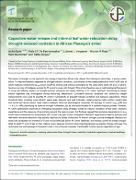Capacitive water release and internal leaf water relocation delay drought-induced cavitation in African Maesopsis eminii

View/Open
Date
2017Author
Epila, Jackie
De Baerdemaeker, Niels J.F.
Vergeynst, Lidewei L.
Maes, Wouter H.
Beeckman, Hans
Steppe, Kathy
Metadata
Show full item recordAbstract
The impact of drought on the hydraulic functioning of important African tree species, like Maesopsis eminii Engl., is poorly understood.
To map the hydraulic response to drought-induced cavitation, sole reliance on the water potential at which 50% loss of
xylem hydraulic conductivity (ψ50) occurs might be limiting and at times misleading as the value alone does not give a comprehensive
overview of strategies evoked by M. eminii to cope with drought. This article therefore uses a methodological framework
to study the different aspects of drought-induced cavitation and water relations in M. eminii. Hydraulic functioning of wholebranch
segments was investigated during bench-top dehydration. Cumulative acoustic emissions and continuous weight
measurements were used to quantify M. eminii’s vulnerability to drought-induced cavitation and hydraulic capacitance. Wood
structural traits, including wood density, vessel area, diameter and wall thickness, vessel grouping index, solitary vessel index
and vessel wall reinforcement, were used to underpin observed physiological responses. On average, M. eminii’s ψ50 (±SE) was
−1.9 ± 0.1 MPa, portraying its xylem as drought vulnerable, just as one would expect for a common tropical pioneer. However,
M. eminii additionally employed an interesting desiccation delay strategy, fuelled by internal relocation of leaf water, hydraulic
capacitance and the presence of parenchyma around the xylem vessels. Our findings suggest that exclusive dependence on ψ50
would have misdirected our assessments of M. eminii’s drought stress vulnerability. Hydraulic capacitance linked to anatomy and
leaf-water relocation behaviour was equally important to better understand M. eminii’s drought survival strategies. Because our
study was conducted on branches of 3-year-old greenhouse-grown M. eminii seedlings, the findings cannot be simply extrapolated
to adult M. eminii trees or their mature wood, because structural and physiological plant properties change with age. The
techniques and methodological framework used in this study are, however, transferable to other species regardless of age.
Collections
- Research Articles [23]
